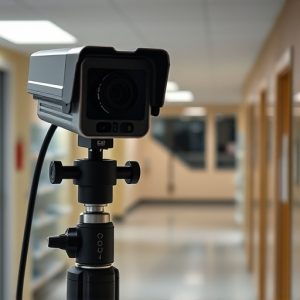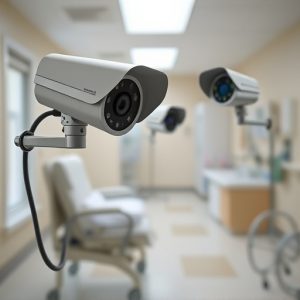Balancing Privacy and Care: The Role of Cameras in Nursing Homes
Cameras in nursing homes play a crucial role in enhancing safety and well-being of residents by off…….
Cameras in nursing homes play a crucial role in enhancing safety and well-being of residents by offering continuous visual monitoring, real-time surveillance, and advanced AI analysis to detect falls or medical emergencies. These systems contribute to detailed care records, helping tailor care plans and improve communication among residents, thereby potentially elevating their quality of life. Ethical deployment involves strict adherence to privacy laws like HIPAA, ensuring transparency, securing personal information, and respecting individual privacy with clear surveillance policies. The integration of these systems prioritizes the dignity and comfort of the elderly, with a focus on non-invasive monitoring that maintains their autonomy. Advanced camera technologies in nursing homes are designed to be unobtrusive, using sophisticated algorithms to distinguish between normal activities and emergencies without compromising privacy. Sensor-based systems monitor vital signs and medication adherence, while interactive communication platforms facilitate engagement with loved ones. Nursing homes must implement robust data security measures and comply with legal standards for privacy protection. The judicious use of cameras has led to improved resident outcomes, with cases demonstrating the technology's ability to empower staff for prompt responses, detect health issues early, and optimize staff allocation for better care delivery. Overall, the integration of cameras in nursing homes is a transformative tool for elderly care, balancing safety, privacy, and quality of life.
Exploring the intersection of technology and elderly care, this article delves into the transformative role of cameras for nursing homes in enhancing monitoring and care. We will examine the nuanced balance between privacy, ethics, and advanced surveillance techniques, offering insights into the latest technological advancements in discreet and non-intrusive monitoring solutions. Furthermore, best practices for integrating these systems will be highlighted to ensure the dual objectives of maintaining security and honoring residents’ privacy are met. Conclusively, real-world examples underscore the tangible benefits and positive outcomes afforded by cameras for nursing homes.
Understanding the Role of Cameras for Nursing Homes in Elderly Care Monitoring
Cameras for nursing homes play a pivotal role in enhancing the safety and well-being of residents. These devices are strategically placed to provide real-time visual monitoring, allowing caregivers to keep a watchful eye on the health and activities of elderly individuals. By offering round-the-clock surveillance, cameras can detect falls, medical emergencies, and other incidents that might otherwise go unnoticed, enabling prompt response from staff or emergency services. Moreover, these systems can be equipped with sophisticated software that uses artificial intelligence to differentiate between routine activities and potentially concerning situations, reducing the risk of false alarms while ensuring the utmost care for residents. The integration of cameras in nursing homes not only fosters a safer environment but also provides peace of mind for both residents and their families, knowing that any signs of distress or abuse can be quickly identified and addressed.
In addition to safety, cameras for nursing homes contribute to the documentation of daily life experiences, which is crucial for maintaining a comprehensive care record. This visual data can aid in assessing a resident’s mood and behavior patterns over time, leading to more personalized and effective care plans. Furthermore, these advanced monitoring systems can facilitate communication between residents who may be unable to verbally express themselves, ensuring their needs are met efficiently. The deployment of cameras is thus not just about surveillance; it encompasses a holistic approach to elderly care, where the dignity and comfort of the individuals residing in nursing homes remain paramount.
Evaluating the Privacy and Ethical Considerations of Camera Usage in Senior Living Facilities
The integration of cameras for nursing homes presents a complex interplay between technology, privacy, and ethical considerations within senior living facilities. As these institutions increasingly turn to advanced surveillance solutions to ensure the well-being and safety of their residents, it becomes imperative to address the potential implications on individual privacy. The deployment of cameras must be carefully balanced with respect for residents’ personal spaces and data protection standards. Ethical guidelines dictate that any monitoring system should be transparent in its use, with clear policies outlining the purposes and limitations of camera surveillance. Residents or their representatives should be fully informed about how footage will be used, who will have access to it, and under what circumstances recording may occur. Ensuring compliance with privacy laws, such as the Health Insurance Portability and Accountability Act (HIPAA) in the United States, is crucial to protect sensitive information and maintain the dignity of the elderly. Moreover, the use of cameras for nursing homes should be accompanied by robust data security measures to prevent unauthorized access or misuse of personal data, thereby safeguarding the privacy rights of residents and fostering an environment of trust.
The Technology Behind Discreet and Intrusive Monitoring Solutions for Elderly Care
In recent years, the integration of technology in elderly care monitoring has evolved significantly, with a particular focus on developing discreet and non-intrusive solutions that respect the privacy and autonomy of seniors. One such advancement is the deployment of cameras for nursing homes designed to be unobtrusive yet effective in ensuring the well-being of residents. These sophisticated surveillance systems are equipped with advanced algorithms capable of distinguishing between normal activities and potential emergencies without compromising the individual’s dignity or privacy. They can monitor a resident’s movements, detect falls, and even recognize changes in behavior that might indicate health issues or other forms of distress. The goal is to provide caregivers with real-time alerts and valuable insights while maintaining a safe and secure environment for the elderly.
Furthermore, the technology behind these monitoring solutions is not confined to visual surveillance. Sensor-based systems are also employed to track vital signs, medication adherence, and even provide interactive communication platforms that allow residents to maintain social connections with family and friends remotely. These systems are designed to be seamlessly integrated into the living spaces of nursing homes, ensuring that the technology serves as an aid rather than a constant reminder of surveillance. The combination of these technologies not only enhances safety but also supports the overall well-being of elderly individuals by providing them with a sense of security and independence. As such, the evolution of monitoring solutions for elderly care reflects a thoughtful balance between technological innovation and respect for human dignity.
Best Practices for Implementing Cameras for Nursing Homes: Balancing Security and Respect for Residents' Privacy
In the realm of elderly care monitoring, implementing cameras in nursing homes presents a delicate balance between ensuring the safety and well-being of residents and respecting their privacy. Best practices in this domain begin with clear communication to residents and their families about the purpose of surveillance and how it will be executed with their dignity and autonomy at the forefront. It’s crucial to adhere to legal standards and ethical considerations, ensuring that cameras are installed in common areas where residents have a reasonable expectation of being monitored for safety reasons, rather than in private spaces like bedrooms or bathrooms. The chosen camera systems should offer high-quality visuals without intrusive audio recording capabilities to avoid any breach of privacy.
To safeguard the integrity of the monitoring system, facilities must establish robust data protection policies. This includes limiting access to the footage to authorized staff only, implementing secure storage solutions, and setting clear guidelines for how and when the cameras are reviewed. Additionally, regular audits and compliance checks can help maintain transparency and trust among residents and their families. By focusing on these best practices, nursing homes can create a secure environment that protects vulnerable adults without infringing on their personal space or autonomy, fostering an atmosphere of safety, respect, and trust.
Case Studies: How Cameras for Nursing Homes Have Improved Elderly Care Monitoring and Outcomes
The integration of cameras for nursing homes has revolutionized elderly care monitoring, leading to marked improvements in resident outcomes. One significant case study involves a facility that adopted advanced surveillance technology, which allowed caregivers to monitor residents’ daily routines remotely. This innovation enabled staff to respond promptly to any observed changes in behavior or health status, reducing response times and enhancing the overall well-being of the residents. The visual data collected from these cameras provided a clearer picture of each resident’s condition, facilitating early detection of potential health issues and allowing for timely medical interventions. Moreover, the presence of these cameras fostered a sense of security among the elderly, as they knew their activities were being monitored by caring professionals, which in turn improved their mental health and quality of life.
Another case study highlights a nursing home that utilized camera feeds to optimize staff allocation based on real-time needs. By analyzing footage, management could identify peak times for resident assistance and adjust staff schedules accordingly, ensuring that residents received the appropriate level of care without unnecessary overcrowding. This strategic use of cameras for nursing homes not only improved the efficiency of care delivery but also enhanced the quality of interactions between staff and residents. The ability to analyze and respond to situations as they arose led to a more personalized and attentive care environment, which is essential for maintaining the dignity and autonomy of the elderly population. These examples underscore the transformative impact of cameras in nursing homes, demonstrating their potential to significantly enhance elderly care monitoring and outcomes.


